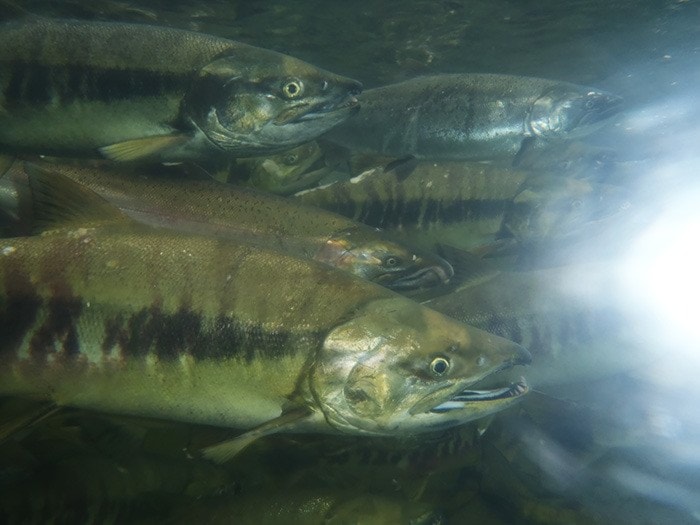Part One
Each year about this time I report on the returns of salmon to the hatcheries in Area 14 waters. This year the report will be on two levels – this column will feature returns to the Department of Fisheries and Oceans (DFO) Hatcheries on the Puntledge, Big and Little Qualicum Rivers in Area 14 and Area 13 Quinsam and Campbell River Hatcheries because they contribute much to our local saltwater fishing. The second report (next week) will feature the many volunteer enhancement facilities that are crucial to the survival of our salmon in our Area 14 small streams and rivers.
The picture with this column features two salmon in the viewing room at the Puntledge Hatchery. The salmon in front of the picture is a prime chum salmon, and just behind it you can see the image of a large hook nosed male coho salmon in full spawning condition.
The Puntledge River is a source of much pleasure to the residents of the Comox Valley. The pleasure is twofold – walking along the quiet nature trails and fishing its waters for salmon on a catch and release system or retention basis when surpluses are available.
We have had two retention fisheries this fall. First was the unexpected pink salmon fishery that was opened by a combination of supportive fisheries officers and a wide awake local sport fishing advisory committee. It was the first time in several years that we had a retention fishery on pink salmon.
The second was the annual retention fishery for chum salmon on the Puntledge that kept many young and not-so-young people happily involved with a good run of salmon. It was a disappointment that chinook and coho have not appeared in numbers large enough to allow a retention fishery.
Without getting bogged down with detailed numbers, I have opted to treat run sizes on a general species basis for our home river. Summer chinook came back in slightly fewer numbers than last year, but did provide brood stock. They are the species of most concern in the Puntledge system.
A big pleasant surprise for pink salmon with about 80,000 showing up to spawn and make anglers happy. Fall chinook returns were a disappointment with an unexpected decline in numbers. The chum salmon did not disappoint with fresh fish entering the river on a daily basis and producing an excellent in river fishery. Current returns of coho are off by about 2,000; but there is still time for late arrivals that will spawn throughout the river and its tributaries right up to January.
In our Area 14 creel survey reports we had an excellent year of chinook and coho fishing. Wild coho (coho with adipose fin intact) were abundant in local waters. It makes you wonder what happened to the Puntledge fish. The hump off Kitty Coleman has been a source of excellent chinook and coho fishing throughout the season.
The same is true for the waters we fish off the south end of Quadra Island and the lower hump south of Campbell River in Area 13. From reports I have had and trips I took part in, there were times when there was an increase in the number of adipose clipped (marked) coho among the large numbers of wild coho caught and released. I suggest that in the 2014 season we may get a retention fishery on wild coho if the increased numbers are more than a one-season blip.
The DFO is not the most popular federal agency in the minds of many people these days; however I would like to compliment the dedicated people who work at the field level in our large DFO hatcheries. They are doing a first rate professional job in face of decreasing budgets and physical challenges due to lack of support services.
Many small stream enhancement facilities depend on the Puntledge and Campbell Quinsam hatcheries for much of their brood stock. Hatcheries are a substitute spawning haven for many runs of salmon that have been decimated by over-fishing, changing ocean conditions, poor forestry practices in headwaters drainages, mining operations that poison the rivers, pollution from many human based activities – to name a few of the problems our fish face in the ceaseless battle for survival. To regional DFO hatcheries this column offers a sincere “Thank-you” for enhancing our 2013 season.
Ralph Shaw is a master fly fisherman who was awarded the Order of Canada in 1984 for his conservation efforts. In 20 years of writing a column in the Comox Valley Record it has wo
